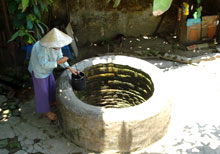The Hoi An Centre for Monuments Management and Preservation has announced a list of 80 ancient wells in the town and neighbouring areas as part of a plan to preserve the relics that are hundreds of years old.
 The list released on May 18 notes that 63 percent of the wells are round; 17% are square and 16% are round at the top and square at the bottom. The remaining 4% of the wells have different shapes.
The list released on May 18 notes that 63 percent of the wells are round; 17% are square and 16% are round at the top and square at the bottom. The remaining 4% of the wells have different shapes.
Researchers say the round-top and square-bottom wells are the inventions of Cham people before the 15th century.
In general, all wells are made of bricks at the top and have square wood frames at the bottom. The frames are designed to make wells stable and last long, preventing their collapse. Bricks are piled without using cement to create leaks so that underground water can flow in and maintain water levels. Most of the wells are located in the ancient town and along north bank of the De Vong River including Thanh Ha Ward and Cam Thanh District’s villages 5 and 4.
While the round wells are mostly found in residents’ houses outside the town, in the town itself the wells are square, or round at the top and square at the bottom. These wells are typically housed in houses of worship and temples of the Hoa people.
On top of the ancient wells are installed altars for worshipping the “Well Godâ€.
Vo Hong Viet, an official of the Hoi An Centre for Monuments Management and Preservation that is responsible for researching the ancient wells, said they were a part of the spiritual life of ancient Hoi An residents. They believed that each well has a genie, he added.
Ancient wells in Hoi An City are often placed 50-150m away from river, but some are placed just 6-10m away.
Despite their proximity to the river that has been salinated by sea-water encroachment, water in these wells is still fresh and retains its natural sweet taste. The water from ancient wells is also a special ingredient in Hoi An culinary specialities like cao lau (noodles with roasted pork) and mi quang (local-style noodles).
Tran Trung Meo, who has been delivering well-water to houses and business establishments for many years, said foreigners who visit Hoi An loved the water.
“They can distinguish between the water from ancient wells and tap-water.†He added that foreigners would not frequent hotels that use chlorinated water.
The city’s patriarchs recall that during the war, water from the ancient wells was popular among foreign soldiers.